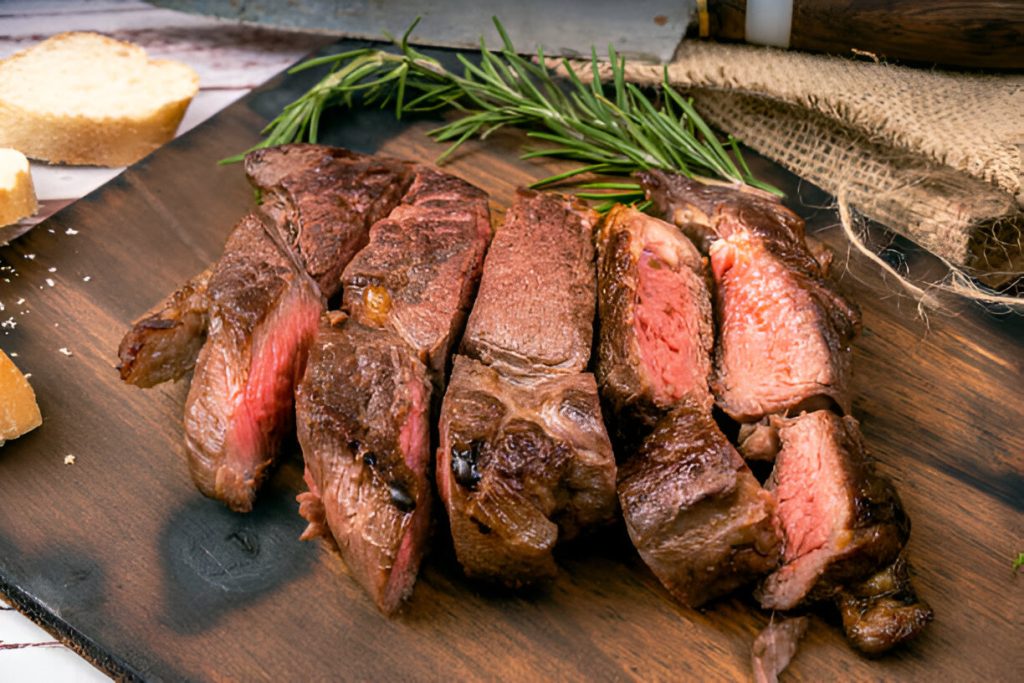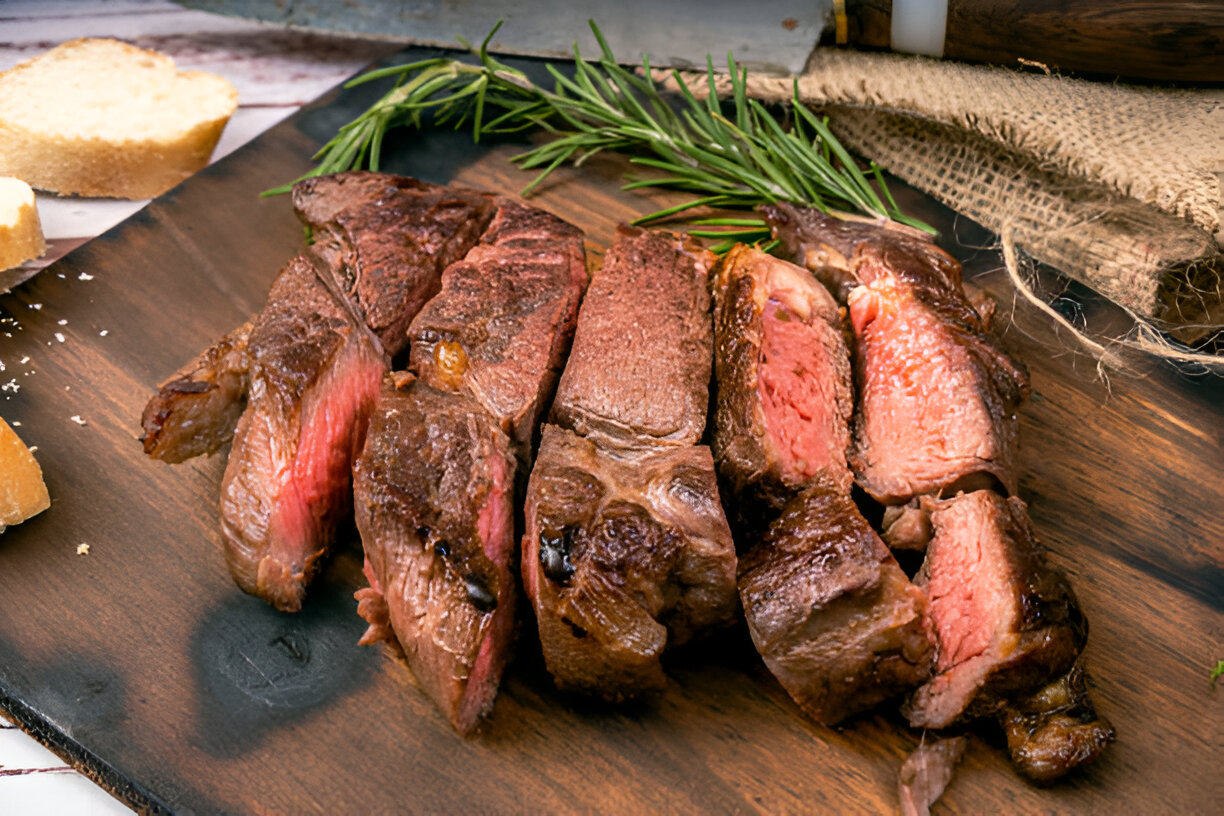Sous Vide Ribeye Recipe
Sous vide ribeye is the pinnacle of indulgence for steak lovers who crave a perfectly cooked, restaurant-quality steak in the comfort of their home. The sous vide technique ensures a juicy, tender finish that traditional cooking methods simply can’t match. This cooking style, which involves vacuum-sealing the steak and immersing it in a precisely heated water bath, brings out the depth of flavor in thick-cut ribeye, allowing the meat to reach a consistent doneness from edge to center. After hours of slow cooking, a quick sear in a hot pan forms a rich, caramelized crust that balances the steak’s buttery tenderness with a satisfying crunch.

Ingredients Overview
This recipe relies on a few simple, high-quality ingredients that build the flavors and textures we seek in an exceptional ribeye. Thick-cut ribeye, typically 1-2 inches thick, is ideal as it maintains a succulent interior through the sous vide process. Garlic powder and onion powder add a savory depth, while coarse sea salt brings out the natural richness of the meat, penetrating evenly through the slow cooking process. Freshly cracked black pepper adds a hint of spice that complements the steak’s bold flavors, and vegetable oil, with its high smoke point, prepares the pan for a flawless sear. Butter finishes the steak, imparting a rich, slightly nutty flavor and creating an enticing sheen.
Preparation Steps
Seasoning the Ribeye
Begin by thoroughly seasoning both sides of the ribeye with a blend of garlic powder, onion powder, coarse sea salt, and black pepper. To elevate the seasoning, firmly press the spices into the meat. This step helps ensure that the flavors meld with the steak during the sous vide process. By embedding the seasonings, every bite will carry a balanced savoriness that brings out the natural taste of ribeye.
Setting Up the Sous Vide Cooker
The sous vide cooker should be set up per the manufacturer’s instructions, with careful attention to temperature control. For a medium-rare ribeye, set the water bath to 130°F. To vacuum-seal the steak, place it in a freezer-safe bag, leaving the bag open. As you submerge it, the water pressure will push out air, creating a natural vacuum effect. Once the air is expelled and the steak is fully submerged, seal the bag securely and clip it to the side of the container to prevent slipping. This water displacement method ensures even cooking without any specialized equipment.
Cooking Duration
Allow the steak to cook in the water bath for a full 2 hours. The extended cooking time at a low temperature guarantees that the ribeye achieves a consistent medium-rare doneness from edge to center. Unlike traditional cooking methods where the steak might be overdone on the outside and underdone in the middle, sous vide provides even results, making the ribeye uniformly tender and juicy.
Searing the Steak
Prepping the Pan
When the sous vide cooking is complete, it’s time to prepare for the sear. Use a cast iron or stainless steel skillet for its ability to retain heat and evenly distribute it across the surface of the steak. Coat the pan with vegetable oil, which can withstand high heat without smoking excessively, allowing the steak to form a rich, golden-brown crust.
Achieving the Perfect Sear
With the pan smoking hot, add the steak and begin searing by flipping every 30 seconds. This frequent flipping promotes an even crust while maintaining the interior’s perfect doneness. About a minute into searing, add butter to the pan and baste the steak with it as it melts. This step adds a deep, buttery flavor and enhances the caramelized crust. Aim for a total searing time of 3-4 minutes, just enough to develop color without overcooking the steak.

Recipe Tips & Frequently Asked Questions
Choosing the Right Ribeye
Opt for a well-marbled, thick-cut ribeye to achieve a rich, juicy flavor. The marbling melts during cooking, ensuring a tender texture.
Seasoning Techniques
Experiment with fresh herbs like rosemary or thyme, or add a hint of spice with crushed red pepper for a personalized touch.
Perfecting the Sear
Keep the pan extremely hot and flip frequently to achieve a crust without overcooking the interior.
How do I ensure my steak doesn’t overcook during the searing process?
By frequently flipping the steak and limiting searing time to 3-4 minutes, you can achieve a crust while preserving the interior’s perfect doneness.
Can I use a different cut of steak with this recipe?
Yes, cuts like filet mignon or New York strip can work well with this method; just adjust the sous vide temperature for preferred doneness.
What is the ideal sous vide temperature for other levels of doneness?
For rare, set the temperature to 125°F; for medium, 135°F; and for well-done, 145°F.
Do I need to let the steak rest after sous vide cooking?
No, sous vide cooking evenly distributes juices, so there’s no need to rest the steak. Slice and serve immediately.
What to Serve with This Recipe
Classic Sides
A ribeye this indulgent deserves equally delightful sides. Mashed potatoes, roasted root vegetables, or a crisp Caesar salad provide balance, each offering different textures to enhance the meal’s overall experience.
Sauce Pairings
To complement the rich flavor of sous vide ribeye, sauces like chimichurri, garlic butter, or peppercorn sauce add zest and contrast. A classic Béarnaise sauce or a red wine reduction also pairs beautifully, bringing elegance to the plate.
Wine and Beverage Pairings
Pair this robust ribeye with a full-bodied red wine like Cabernet Sauvignon, Syrah, or Malbec. The deep, tannic notes in these wines balance the richness of the steak, enhancing its complex flavors. For beer lovers, a dark stout or a hoppy IPA can add a refreshing contrast.
Serving and Presentation Suggestions
For an impressive presentation, slice the ribeye against the grain to showcase its tenderness, revealing the even doneness achieved by the sous vide process. Arrange the slices neatly on a warm plate, adding garnishes like a sprig of rosemary or a few freshly cracked peppercorns for visual appeal. Drizzle a bit of melted butter or sauce over the top for added sheen and flavor, and serve alongside your chosen sides. This approach elevates the presentation, creating a memorable dining experience perfect for any special occasion.

Ingredients
3 tablespoons Vegetable oil (enough to coat the pan)
1 tablespoon Garlic powder
1 tablespoon Onion powder
Sea salt (preferably coarse)
Freshly cracked black pepper
1 lb Thick-cut ribeye steak, about 1-2 inches thick
2 tablespoons Butter
Instructions
Combine the garlic and onion powders in a shaker, if available. This step is optional, but it helps in even distribution.
Generously coat both sides of the steak with the garlic and onion mixture. Follow by liberally seasoning each side with sea salt and freshly ground black pepper. For best results, use coarse salt rather than fine table salt. Press the seasonings firmly into the steak to ensure they adhere.
Prepare your sous vide setup according to your device’s instructions, ensuring the water level in the container can accommodate the submerged steak. Set the sous vide cooker to 130°F to achieve a medium-rare finish.
Place the steak in a large freezer-safe bag, leaving it unsealed. Slowly lower the bag into the heated water, allowing the pressure of the water to expel excess air from the bag. Tongs can be helpful for this, as the water will be quite hot.
Once all air is removed and the steak is fully submerged, seal the bag and clip it to the edge of the container to prevent it from slipping into the water. Cook the steak in the water bath for 2 hours.
After 2 hours, carefully remove the bag from the water. Take the steak out and pat it completely dry with paper towels. This step is essential for achieving a great sear.
Place a cast iron or stainless steel skillet over high heat and add enough vegetable oil to coat the pan, which will help maintain a high smoke point. Ensure your kitchen is ventilated, as the oil will produce some smoke.
Once the pan is smoking hot, add the steak, searing it for a brief 30 seconds on each side, flipping it frequently. After about a minute, add 2 tablespoons of butter to the pan and begin basting the steak as you continue to sear. Aim for a total sear time of no more than 3-4 minutes to prevent overcooking.
Once the steak has reached a rich brown color, remove it from the pan. With sous vide-cooked steak, there’s no need for resting—simply slice and serve immediately. If the steak appears slightly gray initially, it will deepen in color to a beautiful red as it interacts with the air.

Sous Vide Ribeye Recipe
Ingredients
- 3 tablespoons Vegetable oil enough to coat the pan
- 1 tablespoon Garlic powder
- 1 tablespoon Onion powder
- Sea salt preferably coarse
- Freshly cracked black pepper
- 1 lb Thick-cut ribeye steak about 1-2 inches thick
- 2 tablespoons Butter
Instructions
- Combine the garlic and onion powders in a shaker, if available. This step is optional, but it helps in even distribution.
- Generously coat both sides of the steak with the garlic and onion mixture. Follow by liberally seasoning each side with sea salt and freshly ground black pepper. For best results, use coarse salt rather than fine table salt. Press the seasonings firmly into the steak to ensure they adhere.
- Prepare your sous vide setup according to your device’s instructions, ensuring the water level in the container can accommodate the submerged steak. Set the sous vide cooker to 130°F to achieve a medium-rare finish.
- Place the steak in a large freezer-safe bag, leaving it unsealed. Slowly lower the bag into the heated water, allowing the pressure of the water to expel excess air from the bag. Tongs can be helpful for this, as the water will be quite hot.
- Once all air is removed and the steak is fully submerged, seal the bag and clip it to the edge of the container to prevent it from slipping into the water. Cook the steak in the water bath for 2 hours.
- After 2 hours, carefully remove the bag from the water. Take the steak out and pat it completely dry with paper towels. This step is essential for achieving a great sear.
- Place a cast iron or stainless steel skillet over high heat and add enough vegetable oil to coat the pan, which will help maintain a high smoke point. Ensure your kitchen is ventilated, as the oil will produce some smoke.
- Once the pan is smoking hot, add the steak, searing it for a brief 30 seconds on each side, flipping it frequently. After about a minute, add 2 tablespoons of butter to the pan and begin basting the steak as you continue to sear. Aim for a total sear time of no more than 3-4 minutes to prevent overcooking.
- Once the steak has reached a rich brown color, remove it from the pan. With sous vide-cooked steak, there’s no need for resting—simply slice and serve immediately. If the steak appears slightly gray initially, it will deepen in color to a beautiful red as it interacts with the air.
Notes
- Medium Rare: 130°F
- Medium: 140°F
- Well Done: 160°F

